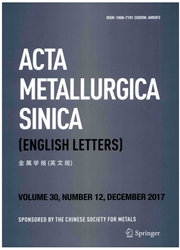

 中文摘要:
中文摘要:
表面上的 finisher 入口温度(联邦货物税) 的效果为极端净化 21%Cr 的隆起的行为以铁酸盐为主要成的不锈钢被调查了。结果显示那减少 FET 便于形成使染色砍在热卷的平板的乐队。in-grain 砍乐队们在通过 subgrains 的结合的随后的退火期间在谷物供应了再结晶成核地点,它是有益的精制微观结构并且加强 { 111 }// ND 质地。这效果将演变到最后的冷卷并且退火的表。微质地的分析显示穿最后的表的谷物殖民地的形成被减少削弱 FET。然后,表面 FSS 的隆起的抵抗由于优化微质地的分发被提高。
 英文摘要:
英文摘要:
The effects of the finisher entry temperatures(FETs) on the surface ridging behavior for an ultra-purified21%Cr ferritic stainless steel have been investigated. The results indicate that decreasing the FET facilitates the formation of in-grain shear bands in the hot rolled slab. The in-grain shear bands supplied recrystallization nucleation sites in grains during subsequent annealing through coalescence of subgrains, which is beneficial to refine the microstructures and intensify the {111}//ND textures. This effect will evolve to the final cold rolled and annealed sheet. The micro-texture analysis indicates that the formation of grain colony in the final sheet is weakened by decreasing the FET. Then, the surface ridging resistance of FSS is enhanced due to the optimizing of micro-texture distribution.
 同期刊论文项目
同期刊论文项目
 同项目期刊论文
同项目期刊论文
 期刊信息
期刊信息
